Barbaresco is more interesting than ever today. The wines are very drinkable, seamlessly tannic and just plain easier to drink than many Barolos, not to mention Cabernet Sauvignon wines. But the best Barbarescos are easily the equal if not superior to the best of Barolo, and this is the place to come for elegant, refined, nuanced Nebbiolo wines like no others. Where Barbaresco fails with respect to Barolo is in the overall less constant regularity of the quality of its wines: there are still too many wines in Barbaresco that are less than what they should or could be. Greater dynamism brought on by new generations entering into the family estates and greater economic stability will no doubt help in tweaking these small problems the denomination still has to deal with. But the future is bright, and will only continue to be brighter.
Last but not least, Barbaresco boasts the best or at no worse one of the three best Regional wine shops of all Italy (the Enoteca Regionale del Barbaresco, right in the town center of Barbaresco) that is well worth a visit to learn about new and potentially exciting small local producers few have ever heard of.
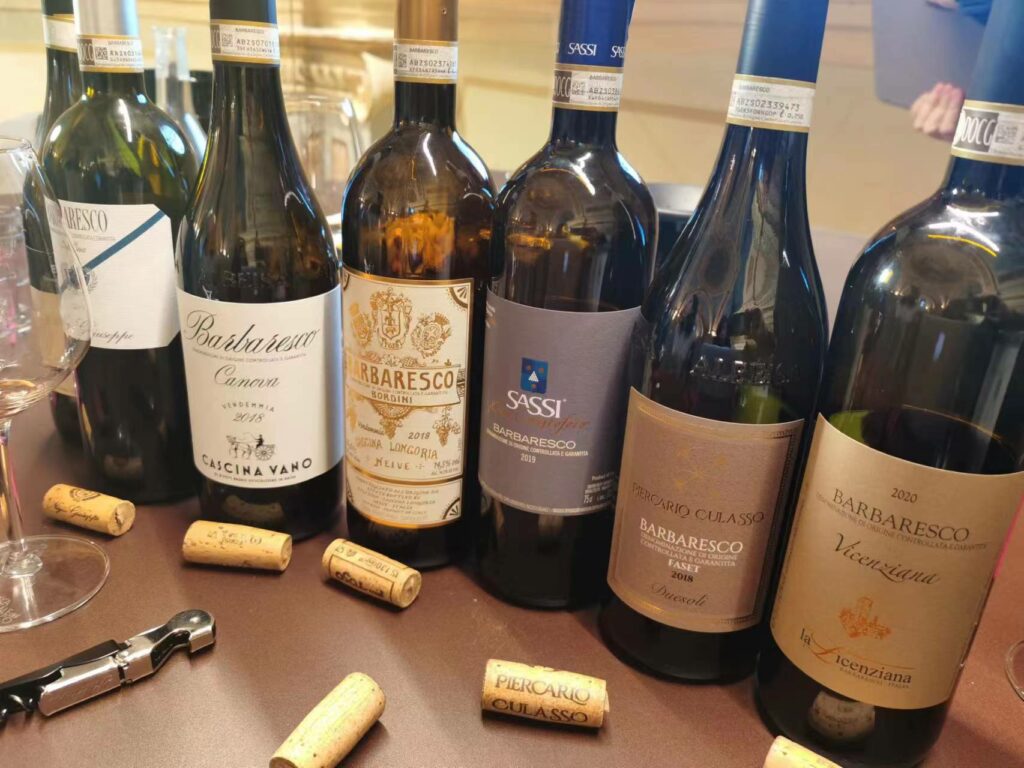
Recent vintages of Barbaresco.
The 2018 was generally a much-maligend vintage but those producers who worked well made some excellent wines. There are fewer truly memorable wines than you will find from the likes of 2013, 2015, 2016 and 2019, but that does not mean the year was a write-off. In general, the Barbarescos of this vintage were ready to drink right away and made for good restaurant by the glass choices (clearly, not all were so) and ideal tipples while the more structured and deeper vintages in your cellar mature. Clearly, in a vintage such as 2018 knowing which producers fared best will make all the difference in successful buying and drinking outcomes (and despite what you might be led to believe by reading some scores, routinely high for all the most famous names in the denomination, in 2018 it’s not always the most famous producers that made the best wines in this difficult vintage). For more information on the wines of 2018, I refer you to my previous article here on the TerroirSense Wine Review: Barbaresco’s New Releases and More: Stellar 2016s, Difficult 2017s, Surprising 2018s and Highly Promising 2019s, Part I and Ⅱ of March 11 and March 18, 2021).
The 2019 is an excellent, classic vintage, though it might have been a hair more successful in Barolo than Barbaresco. The 2019 Barbaresco wines are less exuberant in fruitiness than the 2020s, for example, marked by their noteworthy acidity levels that in the best wines is harmonious and supportive of a long and graceful evolution in bottle. I found many of the 2019 Barbarescos to carry a slightly herbal note that is not usually as apparent in Nebbiolo wines. The growing season was characterized by long daytime heat and sunlight (much more so than in 2018), so the wines are more massive, the caveta being that poor 2019 wines can lack a little freshness. But most people made great wines in this vintage, with some telling me they believed they made their best wines ever in 2019. When I met with Bruna Giacosa at her winery back in March, she told me she finds her 2019 to be a classic year and she loves it; while she finds the Barbarescos to be still very young and a touch hard such that they do not spark the same sate of emotional involvement of other famous vintages, she also pointed out that the wines were finally beginning to open by early 2023 and showing all their undeniable potential for greatness. In fact, Giacosa felt her 2019 wines were so good that she didn’t feel compelled to making a Riserva, given all her vats were more or less on the same level (and to her immense credit, she wasn’t about to go labeling everything with her famous red Riserva label). “Honestly, I would have had trouble picking which lot to label as a Riserva” she smiled. Fletcher is amongst those who believes 2019 the best year in his memory, even better than 2016, finding there’s a perfect acid/fruit/tannin balance to the wines. But as these things usually go, not everyone in Barbaresco was as enthused with the vintage or the wines. Some, a minority perhaps, feel that while there were many wonderful wines made, 2019 vintage was actually not a “great” vintage in the usual sense of that description of a vintage, because it was actually a very difficult year, with too much humidity and rain. The 2019 growing season was characterized by a late spring, that was generally cold and rainy into mid-March. After a brief spell of good weather, rainfall hit again in April, and both rain and lower than usual seasonal temperatures continued into May (the latter month was sunny with average mild temperatures causing vigorous vegetation). This led to as much as a two weeks delay in the physiologic development of the grapevines relative to previous years (but more in line with the vintages of the late-1980s and 1990s). The only truly hot spell of the 2019 growing season was recorded at the end of June and first part of July, with a little storm activity at the end of July that ultimately did not do much damage. The relatively warm summer was followed by a fall of cooler weather (and though Barbaresco was generally spared the hail that was recorded on September 5 in other parts of the Langhe, such as at the base of the Serralunga hill, the flatland vineyard areas and on the outskirts of Alba proper, near San Rocco Seno D’Elvio for instance, did get nailed) which meant a prolonged hang time and important diurnal temperature variations. This is why the Nebbiolo could be harvested in mid-October, allowing for the potential production of complex, age-worthy wines. If there is one caveat, the wines of 2019 are powerful, tannic and structured, with generally high but harmonious acidity levels (in the best wines, at least), meaning they will develop slowly and well, while not offering as much immediate charm as other vintages.
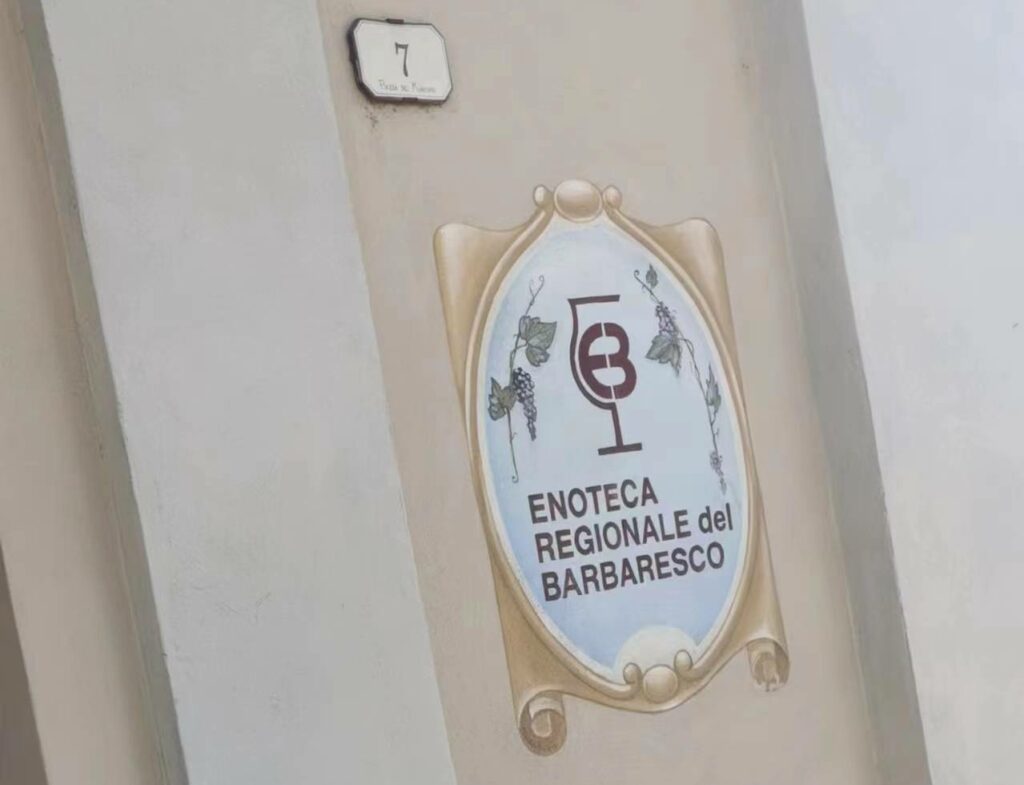
The 2020 was significant for the lack of hail for the first time as well as bigger than usual berries, according to Beppe Colla of the eponymous estate. In his estimation, some of the wines appear to be surprisingly fresher than some of the 2019s but that statement does not apply in a generalized fashion to the 2020 Barbarescos. Given that the year was characterized by some very high summertime temperatures, with peaks of as much as 38 degrees Celsius, that is hardly surprising; however, nighttime temperatures were quite low (for example, similarly to the 2022 vintage and differently from 2019 and 2021). In fact, 2020 recorded the warmest January of the last fifty years, but was followed by a cool March. A very wet April and May and several thunderstorms in June and July made some fear the worst, but the summer was with warm and marked by high sunlight hours, segueing into an ideal harvest season come fall (in fact, the grapes were picked slightly earlier in 2020 than in 2019). My opinion is that the 2020 Barbarescos will need to be drunk sooner than the 2019s, as they are likely to evolve faster, but it is a year of excellent, juicy, suave, very well-balanced wines that will also very likely evolve well.
Most people who don’t travel enough to the Barolo and Barbaresco areas save for the annual all-expenses paid trips organized by the Consorzio and other associations (and the go right ahead and score the wines) often believe that Barolo and Barbaresco have the same weather or that the wines of Barolo are unfailingly the better of the two. That is not the case at all. The 2021 vintage is one that will likely go down as better in Barbaresco. It was overall a very drought but not hot vintage; and while it was rainy in France and Germany, in Piedmont’s Langa it was actually less rainy but colder than usual. However, while the year did start out cold and was charcaterised by frost episodes, you need to be aware that these were prevalent in the Barolo area but not in Barbaresco: especially those valleys of Barolo opened to the north suffered the most. Otherwise, the 2021 vintage was a year of good production as opposed to 2019 (very classic wines), and 2020 (wines with more fruit but less acidity than those of 2021). Fletcher told me his 2021 wines have more structure than his 2020s, but all are equally fresh. Lano likes his 2021 wines more because he found them to have more balance overall; during my winery visit there, he pointed out it was a hot year, but in his estimation, a cool series of nights in September really helped save the vintage and turn it into something memorable. Most everyone told me the colour of the wines is incredible in 2021, with most producers unable to remember a year in which their wines were so deep in hue, “… almost like Barbera in lighter-coloured years”, says Francesco Guermani of Cascina Alberta.
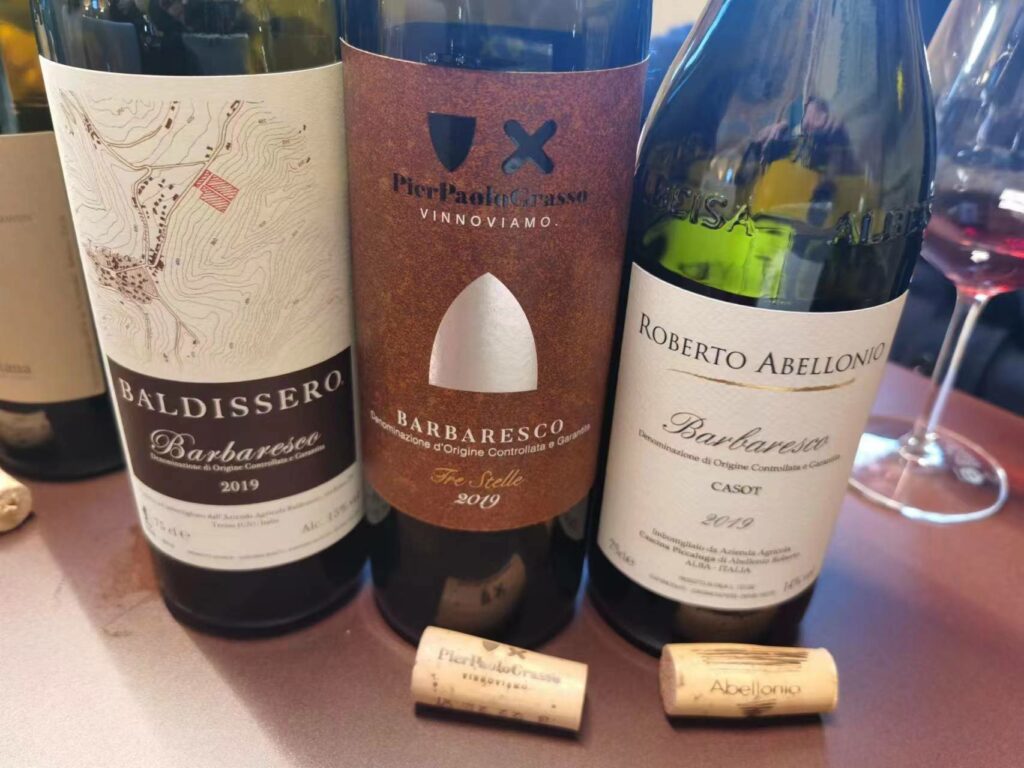
The 2022 vintage was much hotter but because the heat struck early (shades of 2012) the grapes kept higher acidity levels than could have been expected, mostly because the vines had time to adapt to their weather conditions. Clearly, there was no getting around the heat that characterized some summertime periods, and some of the young vines really suffered; southwest exposures were especially dreadful in 2022, and if you consider that most people in Barolo and Barbaresco planted with those very exposures thirty years or so, you realize what that means, though clearly you won’t find too many people saying so. Producers such as Lano, at the time of picking the grapes found very few leaves in the vineyards because they had fallen to the ground been burned off by heat. Therefore, those producers that reacted swiftly to what they saw and tasted during the growing season, rather than rely solely on analytics, were able to react and intervene in a more timely manner and with appropriate measures, ultimately making better wines.
The wines in this tasting report.
All the wines in this tasting report were tasted by me in 2023 directly at the wineries or in one of my two offices, in Rome and Shanghai. As always, I travelled to the relevant Barbaresco areas at my own expense, paying for my trip, my hotel and meals. I do not accept invitations to all-expense paid trips to the production zone and then cheerfully write up the spiel that has been fed to everyone in attendance. This is your guarantee of my impartiality and it is also the guarantee that producers have I will always write it as I see it. Not being infallible, I will, just like everyone else, get some evaluations wrong, but you can rest assured that I know for a fact, after thirty years of visiting the Barbaresco area and tasting its wines regularly (and retasting the same wines from the same vintages just as regularly in the following years), that such unfortunate events happen rarely. Though this article is devoted to Barbaresco, I have also included a few other wines made from other grapes (Freisa, Moscato Bianco) that impressed me greatly and that I think our readers should know about.
This is only part 1 of my annual Barbaresco report; more wineries (such as Moccagatta and Giuseppe Cortese and others) will be covered in part 2 out later next month. As always in my articles, I do not limit myself to covering the big and the beautiful names of a denomination, but very small wineries too. You will find many estate names in this report you will have not read about anywhere else; not all the wines are interesting or worthy of searching out, but it is only by painstakingly visiting as many wineries as possible in a denomination and/or tasting their wines that one can truly learn about and describe what a denomination and its wines really have to offer. It is something that takes an exorbitant amount of time (and cost) but it is something I do gladly for my readers. Always have, always will.
Adriano Marco e Vittorio.
Founded in 1994, Adriano owns thirty hectares under vine (in fact three hectares are rented from a cousin), but they also own twenty hectares of forest and hazelnut. They produce two Freisa wines (a classic Langhe and a Charmat Method Rosé Freisa), Dolcetto d’Alba, two different Barbera d’Alba (a stainless steel one and a Superiore aged six months in large oak barrels), a Langhe Nebbiolo, a Langhe Sauvignon Blanc, and three Moscato Bianco wines (as classic Moscato d’Asti, a classically dry Moscato Bianco wine, and a late harvest version made in 2016, 2017 and 2020, but the latter was made with 50% Nascetta as an experiment). The estate makes 150,000 bottles a year, and their most important wine is the Barbaresco Basarin of which they make 25,000 bottles a year. It is an excellent, underrated winery making Barbarescos that are usually approachable already when young but that will age well.
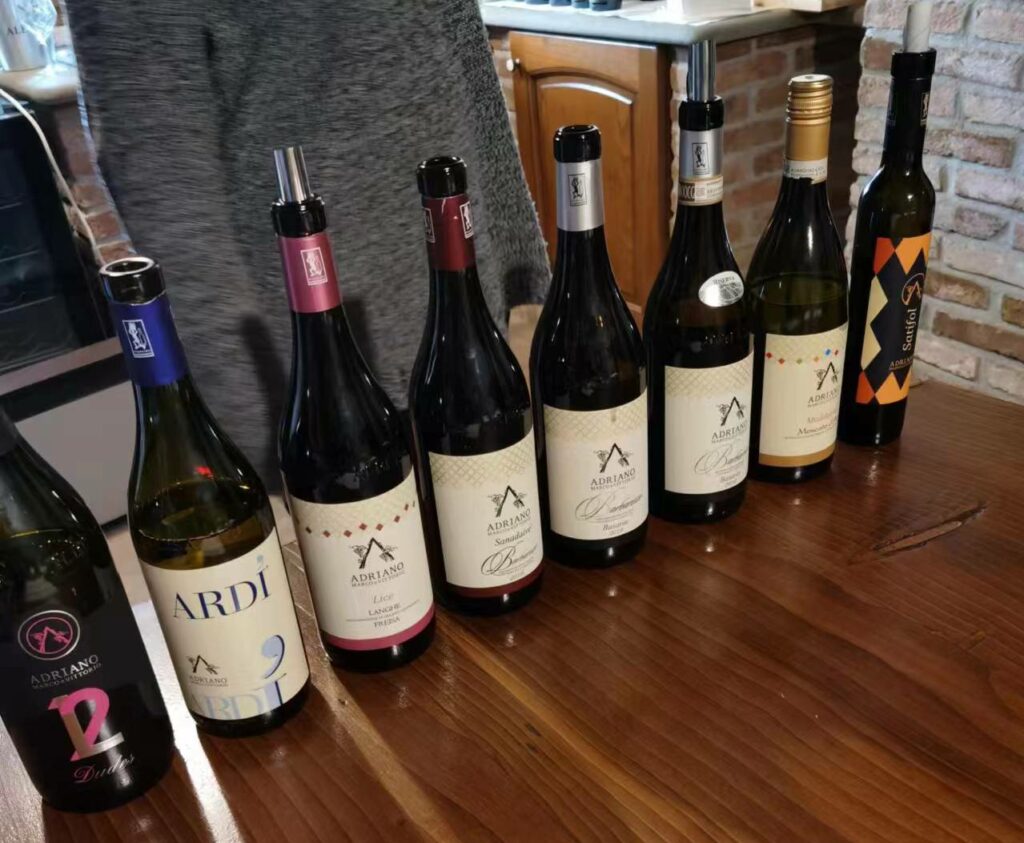
Adriano Marco e Vittorio Freisa Spumante Freis Dudes 93
Medium-deep red. Very pretty wine, with strawberry and cream soda aromas and flavours. Lovely freshness and energy, with very good focus to its pink flowers, small berry and custard cream profile. Skin contact was limited to five-six hours accounting still for a very pretty pale salmon pink colour. Made with the Charmat Method, this spent nine months on the lees. A lovely sparkling Rosato that was thought up and planned with good friend Claudio Fenocchio of the famed Giacomo Fenocchio estate, such that the wine is made with him. Drinking window: 2023-2025.
Adriano Marco e Vittorio 2020 Vino Bianco Ardí 91
Straw yellow. Delicate white flowers and citrus fruit, this is recognizably a white Muscat wine but that won’t be so obvious to most people. This is 100% Moscato Bianco vinified classically dry and is aged one year in bottle so as to release it rounder and less intensely aromatic. The name of the wine is a reference to brave, or “one who faces challenges” (from ardito, in Italian). First made in 2008 and then 2009, the wine initially was not liked in the family because of its intense bitterness and so was not released for sale. Then the 2010 was the first one to be released, one that showed that a slow fermentation helps make the wine rounder and less bitter, such that they don’t need to leave any residual sugar behind (the 2017 bottling had 2 g/ L r.s.). Drinking window:2023-2025.
Adriano Marco e Vittorio 2020 Freisa Lice Langhe 94
Very deep but luminous red-ruby. Impressively concentrated and complex nose of red berries, black cherry, sweet spices, tar and herbs. Then similar flavours with youthfully chewy but noble tannins and very long on the finish that features repeating tar and licorice nuances. Spent one week in contact with the skins and is aged in stainless steel only, to underscore the juicy side of the variety. However, the 2021 was too tannic so they put it three months in large oak barrels (to help round it out) previously used to age Barbaresco. Their vines are planted at the feet of the Barbaresco Vineyard. The wine is called Lice from Felice, an uncle in the family that was named Felice who left them the vineyard as part of inheritance. Along with the 2018, this is the best Freisa wine ever made by Adriano. Drinking window: 2023-2030.
Adriano Marco e Vittorio 2019 Barbaresco Sanadaive 92+
Bright red. Very spicy red cherry and berries, orange peel and apricot on the nose and in the mouth.You can really tell the presence of grapes from Treiso’s Rizzi cru in this year; that, combined with the classic austere nature of the vintage, makes this wine seem a lot tougher and less fruity than it usually is. This will need time in a good cellar before you pull the cork, but promises a long and graceful evolution in the bottle. Skin contact for 35 days, and aged in 35 HL barrels for one year. Made with grapes from 25-30 years old vines from Rizzi and Rocche Massalupo crus. Drinking window: 2026-2035.
Adriano Marco e Vittorio 2019 Barbaresco Basarin 94+
Medium dark red. Aromas of red cherry, cinnamon and minerals. Sweet fleshy red fruit flavours dominate in this big, dense Barbaresco; it’s a lovely wine with plenty of spicy notes but not quite as much as those of the estate’s 2019 Barbaresco Sanadaive. Closes long and juicy, with a twinge of rising bitterness on the noble finish. This is made exactly the same way as the Sanadaive, so as to showcase differences in the respective terroirs, and it’s interesting just how different the two wines are. Drinking window: 2024-2035.
Adriano Marco e Vittorio 2016 Barbaresco Riserva 89
Good full red. Overripe dark cherry, truffle, and earth on the nose, with complicating hints of saltpeter, black pepper and quinine. Then similar flavours on the palate but with also a cherry under spirits quality not unlike that of Amarone or Barbera grown in Lodi, California. Finishes a little drying and tough not to mention high in alcohol (15% and you can tell). Made from fifteen rows in the central part of the Basarin cru and the grapes are late harvested by about ten days and left on skins for 40 days. Undergoes one year and a half in large oak barrels then two years and a half in bottle prior to release.The vines are 25 years old, and it’s worth knowing that the central part of the vineyard from where these grapes are sourced has more marl. Michela tells me they are actually going to release a 2014 Riserva (only 500 bottles) next year, in 2024, after a really prolonged aging in bottle. This is a very impressive wine that those who like the big California reds of the early 2000s will love more than I. Drinking window: 2024-2032.
Adriano Marco e Vittorio 2022 Moscato d’Asti Maddalena 92
Pale straw. Lovely exuberant white flowers, custard, vanilla, peach and grapefruit on the nose. Fresh and lively on entry, then a little sullen but still fresh on the saline finish, with good sweetness. This is the first time ever this wine was bottled with a screw cap. The grapes all come from the San Rocco Seno d’Elvio area, east-west exposed, such that the grapes that ripen best and first are used for Moscato d’Asti, while the grapes that ripen later and spend more time in the daytime shadow are used to make the dry Moscato wine. Drinking window: 2023-2036.
Adriano Marco e Vittorio 2016 Vino da Uve Stramature Satifol 96
Luminous straw-yellow with golden tinges. Very elegant smoky botrytis notes complement the ripe tropical fruit, ginger and tangerine aromas. Then rich and luscious, but with lovely acidity really lifting and carrying the ripe sweet fruit and honeyed flavours on the long cinnamon and ginger-accented finish. This boasts an excellent sugar acid balance (160 g/ L r.s and more than enough acidity to keep it vibrant). Marvelous sweet wine, not unlike something really good you might taste in the Mosel; very very well done. About 70% of the grapes used to make this wine were hit by noble rot in 2016 (as compared to the 2017 that was made all with air-dried grapes). Only 1000 bottles made but make no mistake about it: this is one of the best sweet wines I have had from Italy in some time. Drinking window: 2023-2030.
Angelo Pastura.
Angelo Pastura 2019 Barbaresco Serraboella 87
Good full deep red. Very pretty nose of rose, cranberry and flowers. Enters ripe and fruity, but quickly turns tough and tannic, with a very austere and slightly hollow mouthfeel. Ends too tannic with not much fruit and only average length. I have liked Angelo Pastura’s wines in the past, so I’m not sure what it think of this wine. I guess cellaring for a few years might help soften the tannins a bit, but I wonder. I will retaste this Barbaresco and if I missed something, I will be glad to amend my opinion and score. Drinking window: 2027-2032.
Baldissero.
Baldissero 2019 Barbaresco 91
Vivid medium-red colour. Boasts a rising saline umami note on the long, fresh, nervously tannic but overall smooth finish. Try cellaring it for another three years and see what happens: my hunch is this ought to develop nicely. Drinking window: 2026- 2034.
Bruno Giacosa.
I always enjoy my time spent with Bruna Giacosa, admiring her resolve and ability to make wines that still rank, even after her famous father’s death, with the best not just of the denomination but of Italy. To not want to recognize that is both unfair and incorrect. This pair of 2019 Barbarescos are once again amongst the best wines of the vintage. I look forward to seeing Bruna again later this summer after having spent a wonderful morning this past February at the winery, so as to taste previews of all the upcoming vintages.
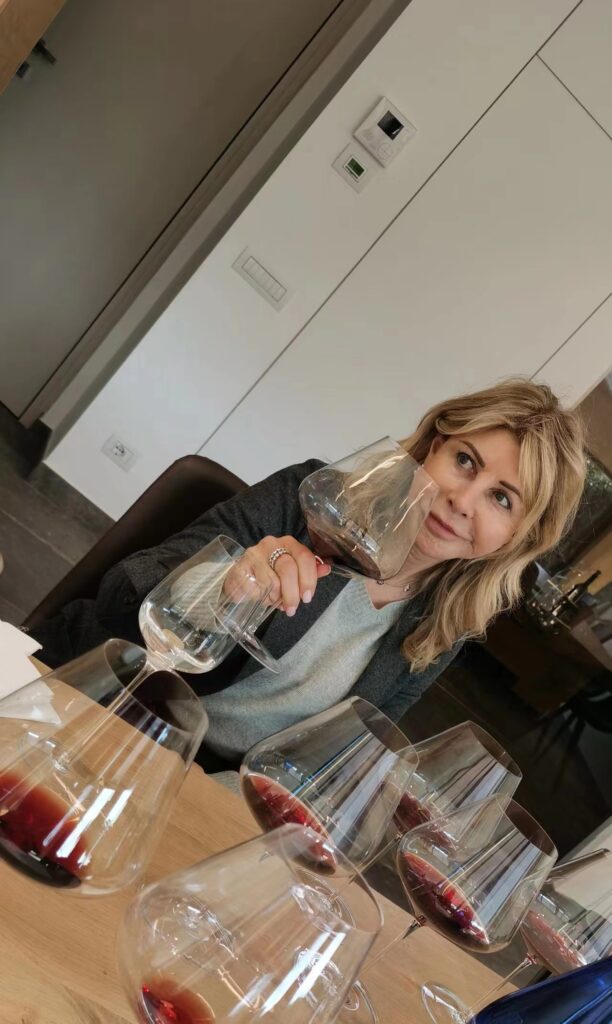
Bruna Giacosa 2019 Barbaresco Asili 96
Luminous deep red. Very pure, saline, fresh and refined aromas of red berries, sweet spices, minerals and sandalwood. Clean and precise, with brilliantly delineated flavours that are very similar to the aromas, this finishes long and pure. A very refined, terroir-accurate Asili Barbaresco bottling. The Bruna Giacosa and Giuseppe Tartaglino duo are acing another vintage. Drinking window: 2028- 2038.
Bruna Giacosa 2019 Barbaresco Rabajà 96
Moderately saturated deep red. Very closed on the nose but pure aroams of dark cherry, tar and camphor hint at huge potential. Then richer and riper in the mouth than the nose suggested (and in typical Rabajà fashion, much more so than Giacosa’s more minerally austere 2019 Asili), with the Rabajà fleshy mouthfeel and lovely Giacosa purity brought out to the fore. The dark cherry herb and spice flavours linger long on the mouthcoating finish. Giacosa owns about 0.5 hectares in Rabajà, much less than their 2 hectares in the Asili. Drinking window: 2026- 2036.
Cascina Alberta.
Previously owned by Giuseppe Contratto (of Contratto fame), it was bought in 2011 by siblings Francesco and Luca Guermani (the latter however is not involved actively in the day to day running of the operation) who were previously involved in another activity (logistic transports) but because they love wine (Chenin Blanc is one of their favourite grapes and wines, as is Riesling, which they decided to plant in 2014). Originally they had seven hectares but are now up to nine hectares as they planted Nebbiolo on two more hectares. Today they produce a Langhe Riesling, two Barbera wines, one Nebbiolo, two different Barbarescos from Giacone and are planning for next year a Barbaresco from Serragrilli. They make about 50,000 bottles a year (the winery has nineteen hectares of which nine are under vine, certified “bio” since 2019, something that is important for Francesco) of which 15,000 are of Barbaresco.
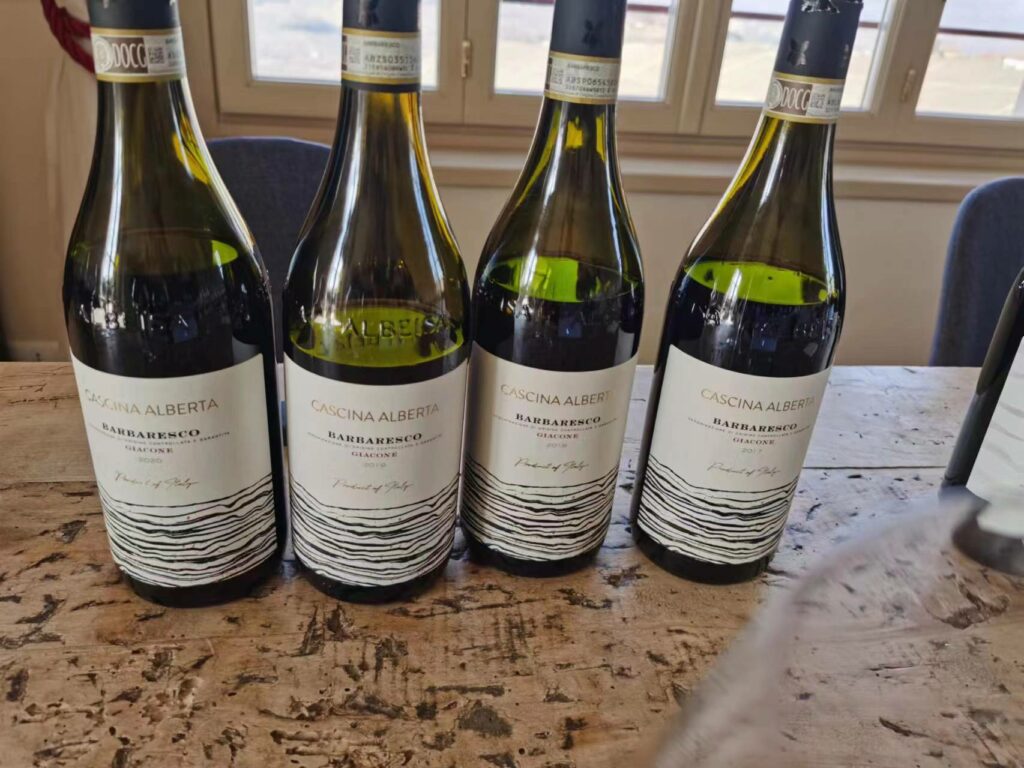
Cascina Alberta 2020 Barbaresco Giacone 92
Good deep, bright red. Lively aromas and flavours of red cherry, menthol, licorice and fresh spices. Fairly big, rich and broad, with a slightly tarry quality and good floral lift. Closes with youthfully chewy tannins. Thirty to forty days on the skins with a maximum temperature of 27 degrees Celsius (but they rarely reach that mark), use of natural indigenous yeasts only are hallmarks of the winemaking. The wine is aged 15 months in large oak barrels. Drinking window: 2026- 2034.
Cascina Alberta 2019 Barbaresco Giacone 95
Good deep red. Herbs and dry spices complicate red and dark berries and plum aromas and flavours. More vegetal than their 2020 Giacone, with some hints of rhubarb, quinine and menthol on the long finish. A very classic Barbaresco that is currently youthfully austere. Finishes long and vibrant with good acidity. Great wine, but less typical of Giacone, which is not normally characterized by vegetal notes such as rhubarb I found this year. Drinking window: 2026- 2034.
Cascina Alberta 2018 Barbaresco Giacone 93
Bright red. Vegetal notes of cut grass, flowers, dandelion, and mint make for a very Treiso-like wine (Barbarescos made with grapes from the commune’s high mountain part, that is). Clean juicy and long, but not especially fleshy (appropriately enough for a Barbaresco from this section of Treiso) closing long, pure and focused, with good vibrant acidity. This is a lovely wine that is ready to drink now and enjoy. Drinking window: 2023- 2030.
Cascina Alberta 2017 Barbaresco Giacone 93
Very pretty pale red. Sweet spices dominate the ripe red cherry and berry syrup notes, but with floral nuances and hints of quinine that convey a noteworthy elegance despite the obvious ripeness of the fruit. Then spicy in the mouth too, with a warm, mouthcoating mouthfeel that is neither gritty nor bitter. Closes very long with a repeating note of quinine. This is surprisingly good for a 2017 Barbaresco (a hot year) but then you’d expect this part of Treiso to do better than most in such growing season weather conditions. Drinking window: 2023- 2029.
Cascina Alberta 2019 Barbaresco Giacone Marne Bianche 95
Vivid red-ruby. Initially oaky on the nose, then perfumed and vibrant with floral aromas of red berries and camphor. Very vertical in the mouth, but richer and denser than the nose suggested with multilayered blue and red fruit flavours lifted by good inner-mouth perfume. Much better (deeper, mostly) than the other Barbarescos I tried at the winery, with a differently impacting tannin. Made from grapes from the highest part in Giacone, where the soil is remarkably white marl-like. A classically austere finish, featuring rising noble tannic clout but also juicy freshness that speaks of the limestone-rich soil. Drinking window: 2027- 2035.
Cascina Alberta 2018 Barbaresco Giacone Marne Bianche 93
Good medium red. Aromas of medicinal red cherry, menthol, underbrush, and herbs, lifted by a whiff of violet. A juicy, lively midweight with good intensity and depth to its medicinal red cherry and herb flavors. The aftertaste is very long and pure, with a steely, metallic, laser-like edge that gives this lovely Barbaresco noteworthy spine. Very Treiso, at least in the colder, higher part of the territory (think of the Bricco di Treiso wines, if that tells you anything). Drinking window: 2025-2032.
Cascina delle Rose.
One of the many high-quality but underrated wineries of Barbaresco, the grapes come from three Nebbiolo vineyards planted in 1998, 2012 and 2017, of which only the one planted in 1998 is officially a Barbaresco vineyard (and in fact the majority of those grapes are used to make the Barbaresco Tre Stelle).
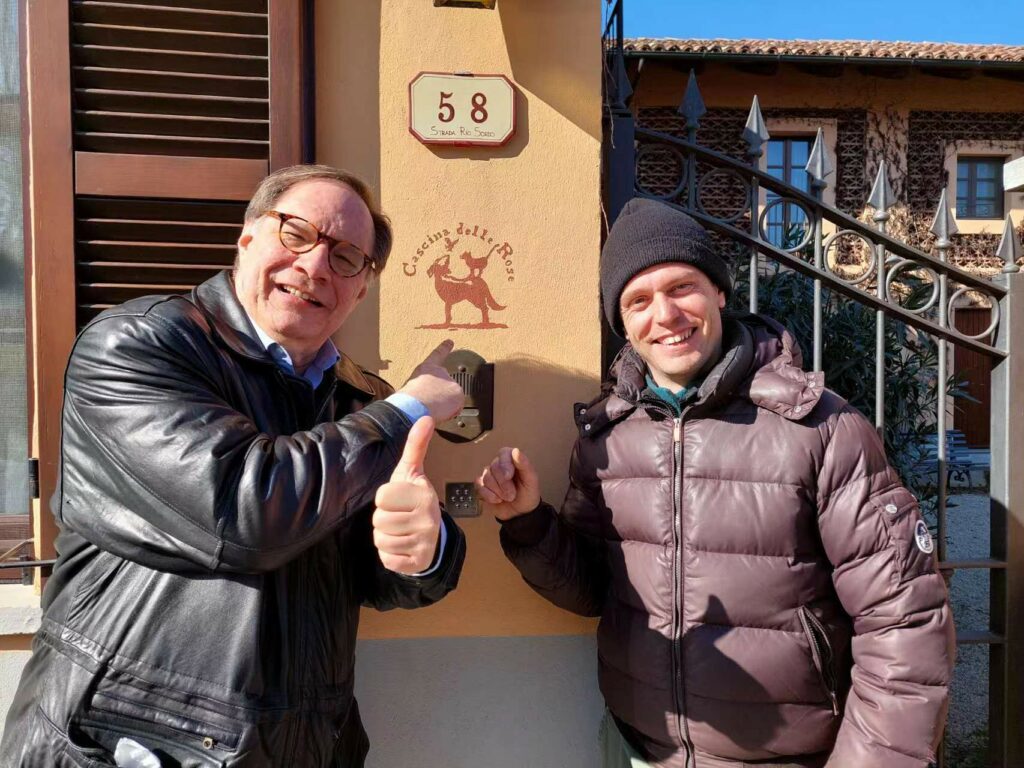
Cascina delle Rose 2021 Nebbiolo Langhe 93
Bright red. Floral and sour red cherry aromas are complicated by a decadent note of superripe cherry, consistent with the hot year. Very perfumed, fresh and saline on the long finish (the saline/savoury component comes from the amphitheatre-shaped vineyard planted in 2012). Although this article is devoted mostly to Barbaresco, this wine is so good I just had to tell you about it; in fact, this may well be the best Nebbiolo Langhe I have tried all year. Drinking window: 2023-2027.
Cascina delle Rose 2019 Barbaresco Tre Stelle 95
Bright medium red. Aromas of red cherry, tobacco, dried flowers, flint, orange peel, and botanicals. Juicy, sappy and fresh, with good energy and definition to the perfumed flavors of red berries, dried flowers and sweet spices. Finishes with firm but suave tannins and outstanding length, not to mention and subtle, lingering mineral presence. Very pure and elegant, this is an outstandingly excellent Barbaresco from start to finish. Drinking window: 2025-2036.
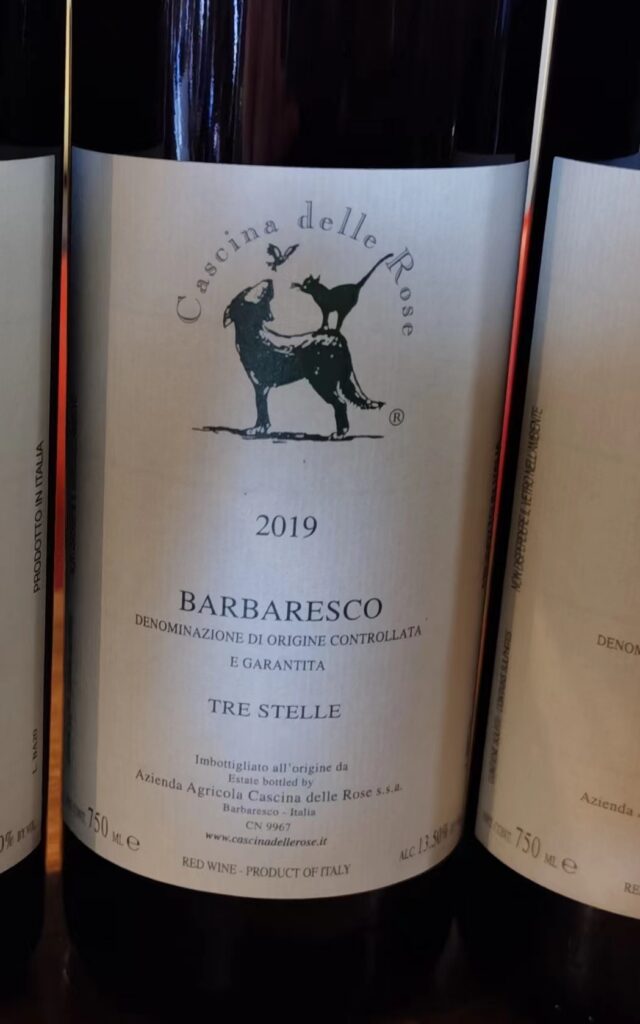
Cascina Longoria.
Cascina Longoria 2018 Barbaresco Bordini 87
Garnet-tinged red. Strong gamey and leathery nuances camouflage the red fruit aromas and flavours. Closes medium-long and broad, but I w as left wanting a little more purity of fruit and less funky barnyard presence. Drinking window: 2025-2030.
Cascina Roccalini.
Cascina Roccalini 2020 Barbaresco 94
Good dark red. Wild aromas of musky red plum, red currant and tobacco are complemented by smoky and truffley nuances. Plush, plummy and full, with very well balanced, with sultry red cherry syrup and sweet spice flavours that are nicely persistent. I especially liked the long silky finish. Drinking window: 2026-2034.
Cascina Roccalini 2019 Barbaresco 91
Good medium red. Red berry liqueur and a light herbal and spicy quality on the nose. Moderately supple and pure, with good herbal lift to the ripe, decadent, sweet and spicy red fruit and spice flavors, but a little tough, even coarse, on the long finish. Drinking window: 2028-2035.
Cascina Vano.
Cascina Vano 2018 Barbaresco Canova 89
Good full red. Rich and deep on the nose with aromas of violet, red and dark cherry and truffley underbrush. Then a little monodimensional and less complex in its somewhat chunky flavours of red fruit, tobacco and coffee. Finishes a little short, with tannins that are a bit too assertive presently. Try after 2026. Drinking window: 2026-2032.
Ceretto.
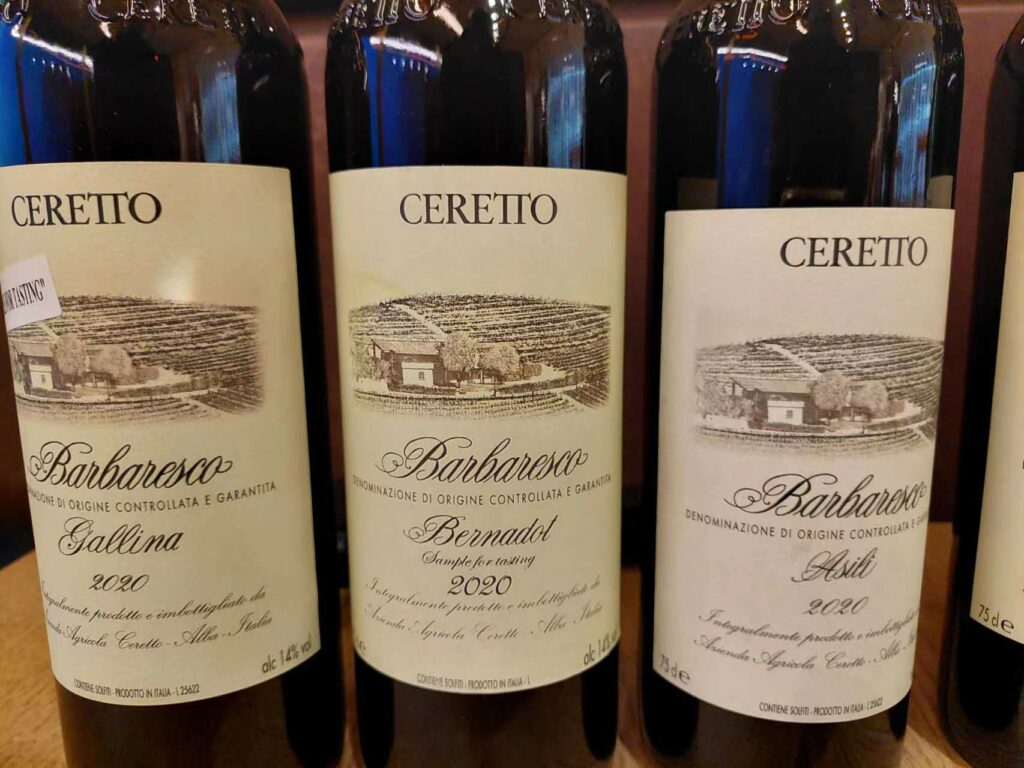
Ceretto 2020 Barbaresco Gallina 94
Medium bright red. Cherry, plum, underbrush, licorice and sweet spices on the enticing nose; hints at a liqueur-like ripeness but is actually very fresh. Then also very sweet and pliant on entry, but very nicely delineated thanks to strong, integrated acidity leaving an impression of penetrating power. Very pretty, easygoing, sweet gentle Barbaresco that is just plain lovely and irresistible. Only about 3000 bottles made. Drinking window: 2026-2036.
Ceretto 2020 Barbaresco Bernadot 93
Good full red with a hint of garnet at the rim. Slightly high-toned, liqueur-like aromas and flavours of red cherry preserves, plum and smoky tobacco. Plush and spherical but not especially primary, and very strongly marked by coffee and tobacco on the log finish that speaks of the relatively warm year. Drinking window: 2026-2034.
Ceretto 2020 Barbaresco Asili 96
Bright medium-dark red. Sexy aromas of raspberry, tobacco, dried rose and minerals. Silky and seamless in the mouth, with nicely concentrated, seductively sweet red fruit and spicy mineral flavors. Finishes with firm but suave tannins and very good length. Suave, clean, precise and focused, this is just about all you could ask for from a Barbaresco in the 2020 vintage. Well done. Amazing how the nobility of the Asili vineyard district, a true grand cru for Barbaresco if there is one, shines through. Drinking window: 2028-2036.
Cogno.
Cogno 2020 Barbaresco Bordini 95
Bright red. Lovely red cherry, blackberry and truffley aromas and flavours are clean, energetic and pure. Very balanced and very pretty, this closes long and silky. Maybe the best Barbaresco Bordini Cogno has ever made. Drinking window: 2027-2036.
Agricola Molino.
Formerly known as Fratelli Molino, the winery changed name with 2013, and is now run by Marco (since 2012) and his cousin Francesca (who just joined him in 2022), who both help out their parents and uncles, Franco (who follows the vineyards), Tommaso (in charge of the commercial side of things) and Dario (the latter has always been the winemaker of the estate). They produce 80,000 bottles/year, of about 15,000 of which are Barbaresco. They also make a Dolcetto, Chardonnay, Arneis, two Barbera, and a Moscato d’Asti wines. The winemaking typically involves a contact time on the skins of about 10-14 days and maximum temperatures in fermentation of 27 degrees Celsius, and native yeasts are being studied for future use.
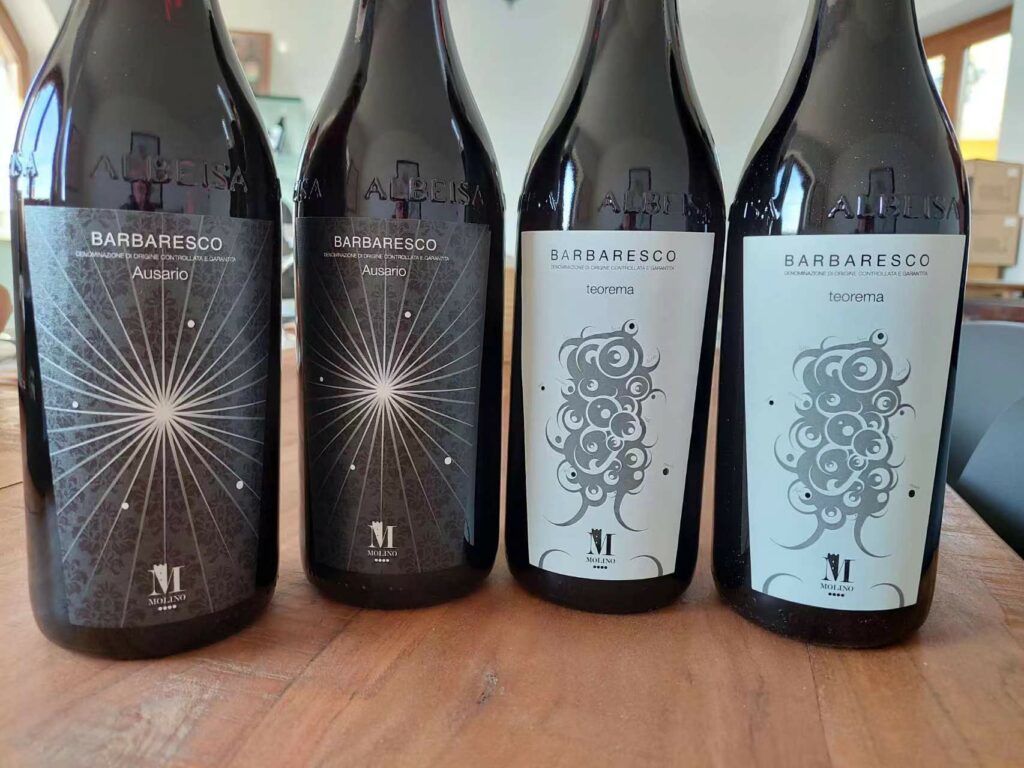
Agricola Molino 2020 Barbaresco Teorema 93
Bright red. Peach, orange, red berries and hints of violet and licorice on the nose. Then similar flavours plus an earthy nuance that turns more floral and penetrating with aeration. Suave fresh and saline on the cool long finish. A blend of 80% San Rocco Seno d’Elvio and 20% Ausario grapes from the latter cru’s younger vines. Very little new oak here (spent about 18-20 months in oak). Drinking window: 2026-2034.
Agricola Molino 2019 Barbaresco Teorema 94
Bright red; deeper in hue than the 2020. Quinine, orange peel, and red fruit are complemented by some green nuances on the pretty, forward, but also deep nose. Enters smooth, full-bodied and round, with a peppery elegant nuance that adds freshness and lift to the very sweet red fruit flavours. Finishes long and spicy with a hint of orange peel and white pepper. There’s real sneaky density here belying the fact these are roughly 25 years old vineyards.Very pretty Barbaresco. Drinking window: 2026-2036.
Agricola Molino 2020 Barbaresco Ausario 95
Deep ruby-red. Brooding aromas and flavours of dark berries, red plum, earth tones and tobacco. Slightly chewy but youthful tannins provide backbone on the long, spicy mouthcoating close. Almost entirely aged in barriques (about 20% new). This is a beautiful Barbaresco, the vines from where the grapes were sourced was planted in 1958 with mix of the three main Nebbiolo subvarieties. Drinking window: 2028-2038.
Agricola Molino 2019 Barbaresco Ausario 94+
Deep red. Closed but refined nose of minerals and red cherries are complicated by a delicate green note that adds refinement. Very clean and precise on the long, elegantly austere finish that speaks of the freshness of the year. A very cool, high mountain Treiso-like wine with a rigid mouthfeel but also size and flesh. Drinking window: 2028-2040.
Fletcher.
Original of Adelaide and graduate of the University there, after living In Melbourne for eight years and working in Yarra, he staged at Ceretto in 2007 and the rest as they say is history. He loved it there so much that after a stint in Kazakhistan he came back in 2009 at Ceretto (and also Lorenzo Arlutto), then went back and forth between Australia and Italy (buying grapes and bottling two different Nebbiolo wines there). He moved back to Italy and Ceretto and stayed until January 2023, when he set out on his own. His winemaking style does not contemplate the use of whole berries because he believes the aromatics they bring contrast with the typical aromatic florals of Nebbiolo, which he (rather understandably, I may add) he doesn’t see the point in doing.
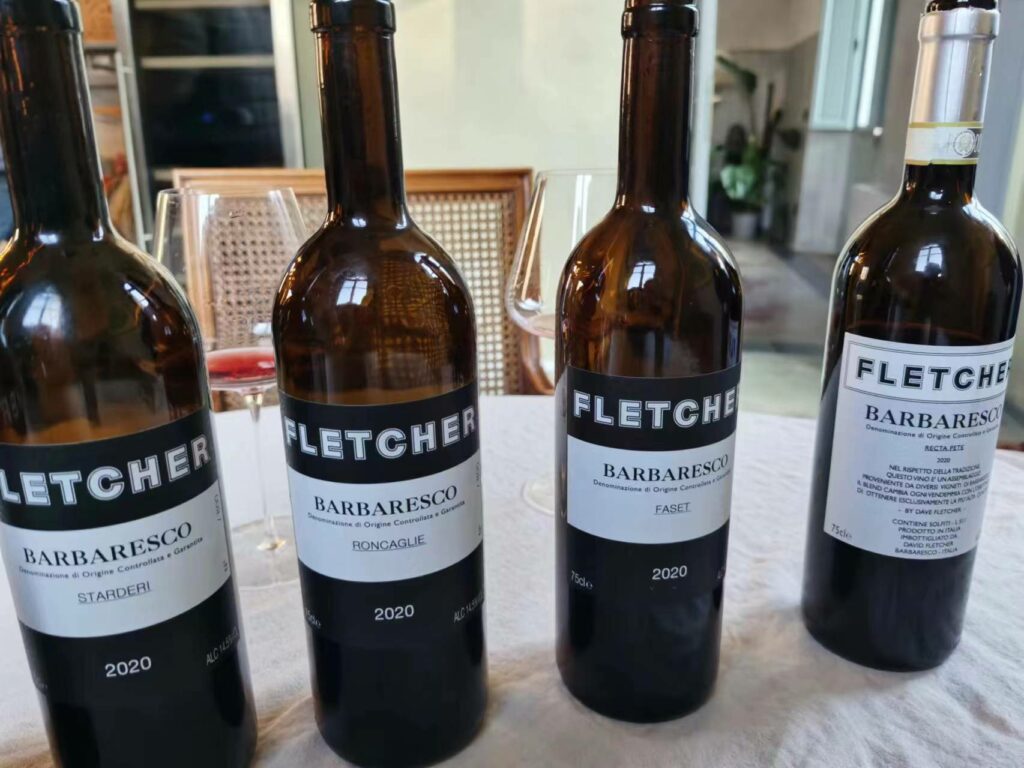
Fletcher 2020 Barbaresco Recta Pete 93
Good full, deep red. Offers dark berry, violet and licorice aromas and flavours complicated by a note of chocolate. Tight and sappy in the mouth, with a medicinal edge and very good focus to the dark berry and spice flavors. Less sweet and plush than I expected from this vintage but has plenty of structure for aging. Starts with a Barbera-like juiciness here, but finishes a little drying but with rather magical lift and with copious violet perfume. This is a 50% Roncaglie, 35% Starderi, and 15% Ronchi blend aged for two years in open fermenters of used oak. Recta Pete means ‘shoot straight’, a wink to David’s Scottish family’s heritage as former arrow makers and his vision of what Barbaresco ought to be. Drinking window: 2027-2037.
Fletcher 2020 Barbaresco Starderi 94
Luminosu red. Perfumed raspberry, strawberry, orange peel and minerals on the nose and in the mouth. Very pretty, silky wine that is not unlike a strawberry cocktail with alcohol. Closes very long, fresh and pure, you’ll have a tough time putting a full glass of this back down. What I like most about this wine, and to be clear there’s plenty to like, is how accurately it represents what Starderi cru can give: nothing at all like the brooding chocolaty massive wines that some other Barbarescos from this cru have been associated with over the years. Rather, Starderi gives a very gentle, suave, fruity and approachable Barbaresco. Bet you’re surprised, right? Well, it’s never too late to learn something in life. Drinking window: 2025-2036.
Fletcher 2020 Barbaresco Roncaglie 93+
Good dark, bright red. Subtly complex and enticing aromas and flavours of blackcurrant, minerals and underbrush. Juicy and penetrating, with harmonious acidity energizing the middle palate and the firm red fruit and underbrush flavours. At once youthfully tough and austere but also elegant in the classic Roncaglie rendition of Barbaresco. Better after 2028. Drinking window: 2028-2038.
Fletcher 2020 Barbaresco Faset 95
Vibrant red colour. Broad aromas and flavours of spicy tobacco and ripe red cherry are open-knit and fleshy. Easy to understand and to like, this lovely Barbaresco boasts plenty of juiciness and mouthwatering citrussy acidity. Every time I have a Faset this good, and that is also this sneakily complex, I really find myself thinking I have always underrated the site. Drinking window: 2026-2038.
Lano.
The winery makes about 30,000 bottles of which about 80% are about exported. The estate owns and rents six hectares (four are owned), all under vine. Unfortunately, Lano was unable to make a 2019 Barbaresco because of a severe hail storm that hit very late around September 20 (the same hail episode that destroyed many of the vines in the Madonna di Como area, and so he declassified everything to Langhe Nebbiolo). Readers would do well to search put for Lano’s Freisa, one of the best wines made with this noble but difficult grape variety, the wines of which are very much like Nebbiolo in their aroma and flavour profile.
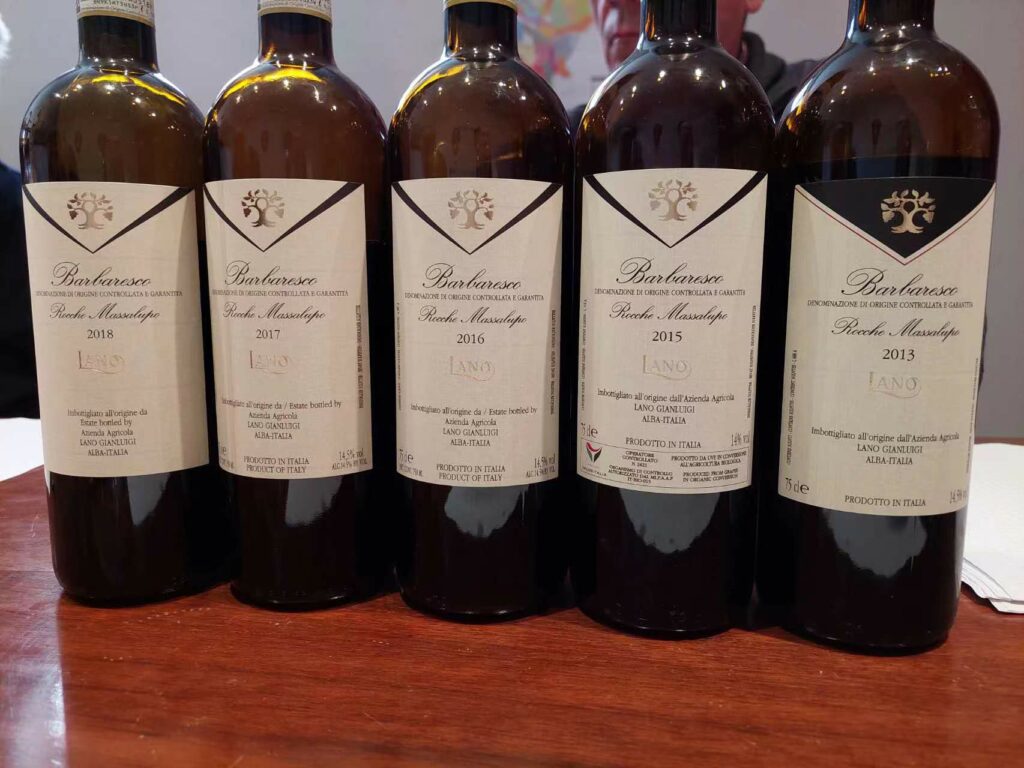
Lano 2018 Barbaresco Rocche Massalupo 93
Luminous medium-bright red. Very pretty wine with floral and juicy red berries and cherries on the open-knit nose. Clean, steely and youthfully tactile with a note of licorice emerging on the long juicy back end. Delicious example of a well-made 2018 Barbaresco. Drinking window: 2024-2032.
Lano 2017 Barbaresco Rocche Massalupo 94
Bright red. Perfuemd aromas and flavours of red fruits and spices offering superb vinosity and flesh. The persistent aftertaste is mouthcoatingly rich and pure. A very difficult year but Lano, having a very small holding in the cru, was able to intervene speedily and avoid the grapes getting killed by the heat (at the time he owned only 0.6 hectares, now it’s 1.1 after removing the Freisa and Barbera hit by hail). The original vines are over fifty years old, while the younger ones are only five years old. However this 2017 is made with only the fifty years old vines. This wine is a testament to Gianluigi’s wine talent: though undoubtedly tannic, they are relatively smooth and noble. If you weren’t yet convinced by the man’s talent after tasting his wonderfully delicious Freisa wines, then this 2017 Barabresco will convince once and for all. Drinking window: 2024-2033.
Lano Barbaresco 2016 Rocche Massalupo 95
Bright red colour. Refined, multilayeerd aromas and flavours of raspberry, strawberry, pomegrate and herbs, complicated by hints of tobacco, cinnamon and nutmeg. Dense, plush and focused and energetic, with impeccable acid-fruit balance and a very long finish of small red berries, cherry and cinnamon. Really beautiful Barbaresco, that showcases just how great the 2016 vintage was for Nebbiolo in the Langhe. Drinking window: 2026-2036.
Luigi Einaudi.
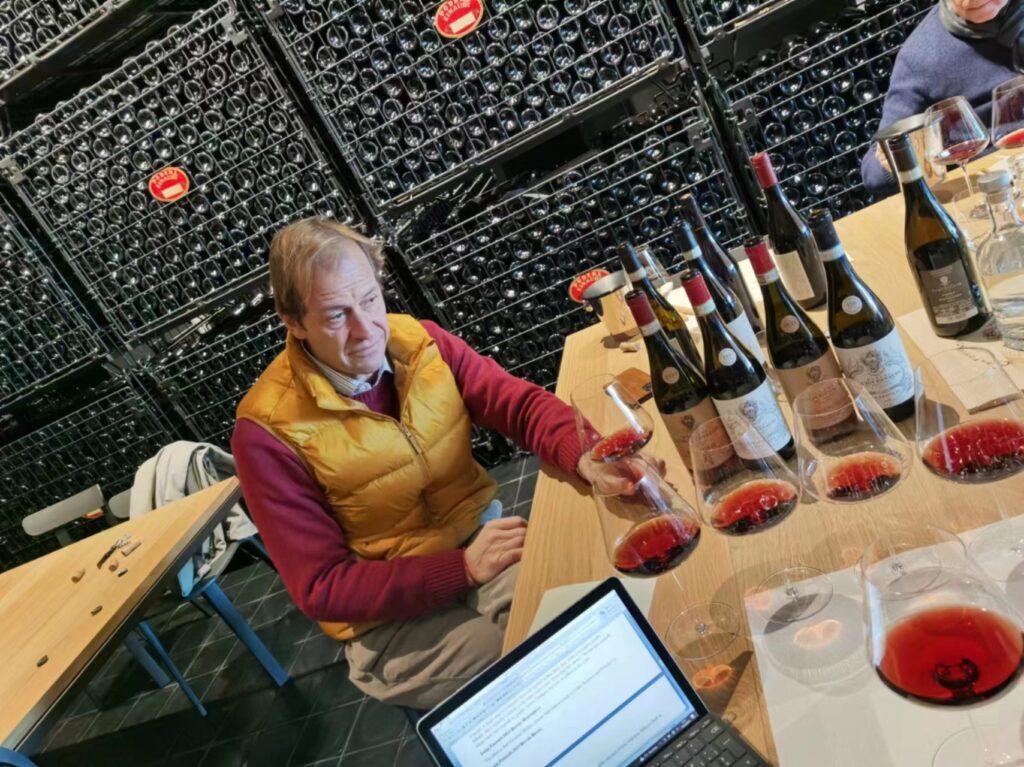
Luigi Einaudi 2020 Barbaresco 92
Luminous red colour. Pomegranate, cranberry and herbal nuances on the nose and in the mouth. Brightly saline with clean and focused hints of menthol on the medium-long but very clean and fresh finish. From the Bricco Micca area of Neive, this is much fatter and richer than Einaudi’s 2019 Barbaresco, though both wines will have their fans. Drinking window: 2026-2036.
Francone.
The big news at Francone is that starting with the 2020 vintage the estate will be releasing two new Barbarescos from specific crus, Albesani (where Bruno Giacosa used to make his stellar Santo Stefano Barbaresco) and Starderi. Fabrizio made his first vintage in 1991, but started working with his father Mauro (his first vintage was 1964) in 1989.
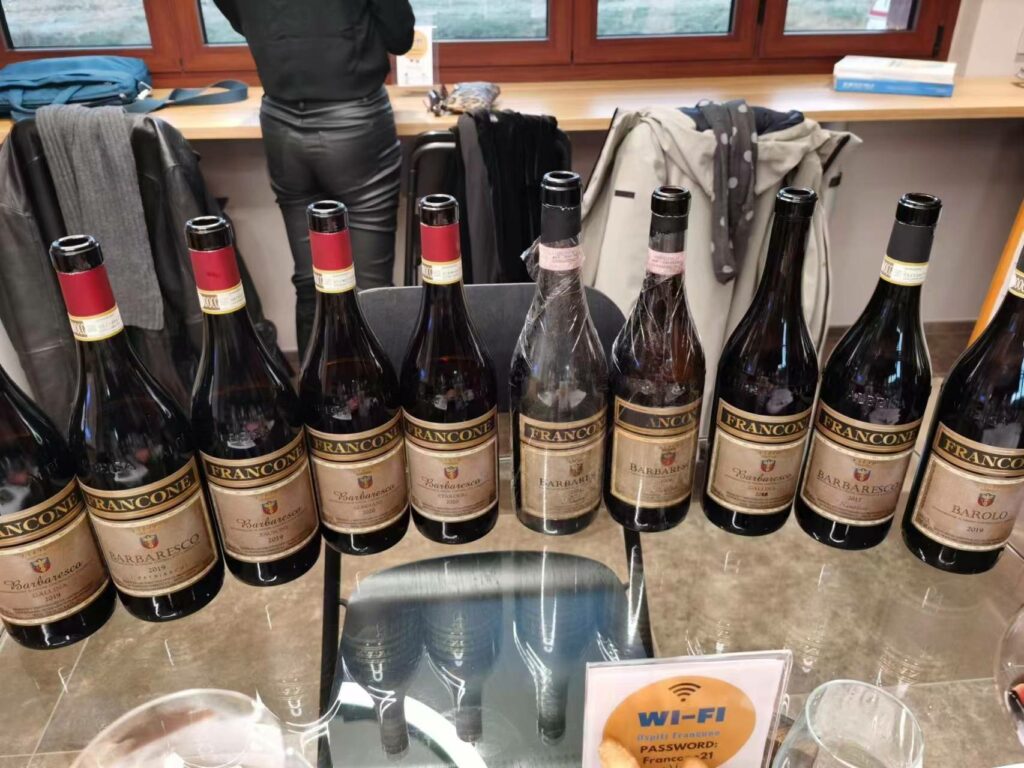
Francone 2020 Barbaresco Albesani 94
Bright pale red (note that in 2022 this wine is instead quite dark and purple); the light colour is because the Francone plot of vines is on the top of the hill so the anthocyanins get burned in warm years and the colour of the resulting wine is usually lighter than most. Very pretty nose of sweet red cherries, cinnamon, nutmeg, orange peel, marzipan and raspberry coulis. Then sweet and savory, with smooth tannins and harmonious acidity nicely extending the flavours on the luscious finish. Aged eighteen months in half third fill barriques and another half in 12 hL barrel. Drinking window: 2026-2036.
Francone 2020 Barbaresco Starderi 92
Deep red; remarkably darker than the Albesani, but still well within my normal parameters of a 100% Nebbiolo wine. Very strong notes of pine and fresh citrus on the balsamic nose, which features red cherry fruit in the background.Then light and lively with juicy acidity and a light on its feet personality. Finishes with hints of chinotto bitter citrus fruit. Drinking window: 2026-2036.
Francone 2020 Barbaresco Gallina 91
Deep red. Very spicy nose of black pepper, blackberry reduction, and red cherry syrup. Fresh and nervous, mineral even, with a textured mouthfeel that lasts and lasts. Tasted about two weeks before going into bottle at the end of February 2023. Remained 24 months in oak (the first six months in tonneaux and then the rest in big large barrels). Drinking window: 2028-2036.
Francone 2019 Barbaresco Gallina 94
Deep red. Menthol and pepper complement red and dark cherry on the inviting nose. Big mouthcoating and very spicy mouthfeel, finishing long with hints of cedar and herbs along with the dark cherry of the nose. Not gritty, but the tannins certainly need to settle down so cellaring this baby for another five to six years or so is a must. Bottled in June 2021. Unlike the 2020 that spent 24 months in oak this only eighteen months in oak (Bethomieu, Gillet and Gamba oak barrels). Drinking window: 2028-2038.
Francone 2019 Barbaresco Fausoni 94
Medium-pale red. Very perfumed and floral on the slightly spicy and citrussy nose. Fresh and lively in the mouth, with very good palate pèresence to the fresh red and black fruit flavours complicated by a hint of cocoa. Strikes me as a very good fausoni in which the acid/fruit/tannin balance is quite good. Finishes with good spicy cut and very well dosed oak. About 2600 bottles made in this vintage. Drinking window: 2026-2036.
Francone 2019 Barbaresco I Patriarchi 88
Good full red. Not especially refined on the chunky nose and mouth, with ripe fruit and dark chocolate aromas and flavours. A big chunky wine that I find to be not so nuanced and a little hot on the back end. This is the last I Patriarchi to be made with Albesani and Starderi grapes, this was roughly 55% Fausoni and Cottà, and 45% Albesani and Starderi. Aged two years in 1200 liter barrels. About 5300 bottles a year made. Drinking window: 2025-2031.
Francone 2017 Barbaresco Riserva 94
Light red. Peach, red cherry and strawberry on the enticing nose. Ripe round and long, with a clean and very pretty aftertaste of red cherry and strawberry delicately complicated by sweet spices and tobacco. Amazing wine, 100% Fausoni grapes the vines of which were planted in 1954 with a southwest exposure. Stays 42 months in oak (1200 liter oval barrel and 700 liter tonneaux, all French and Swiss oak, none new). 2600 bottles made. I’m not normally a fan of 2017 barbarescos, but I’d say this is worth buying. Drinking window: 2025-2036.
Fratelli Giacosa.
The family owns and rents land in different Barbaresco crus: the biggest holding is in the Basarin cru of Neive (Basarin and Vigna Gian Maté), but also in San Giuliano and Albesani.
Fratelli Giacosa 2020 Barbaresco Basarin 92
Medium bright red. Slightly raw but crunchy red cherry minerals on the nose and in the mouth. Slightly astringent now but not gritty, so I think this will improve with proper cellaring (this will be sold starting in January 24). Better after 2026. Drinking window: 2026-2036.
Fratelli Giacosa 2020 Barbaresco Basarin Vigna Gianmaté 93+
Deep red. Richer and deeper colour-, aroma- and flavour-wise compared to the Fratelkli Giacvosa 2019 Basarin, this is also riper in its black cherry and cocoa aromas and flavours. Hints at cherry marmelade on the long finish but peppery freshness provides lift and length. Nicely tannic Barbaresco that will further evolve and smoothen. Drinking window: 2026-2036.
Fratelli Giacosa 2019 Barbaresco Basarin 94
Bright red. Perfumed rose and violet complement red cherry and mineral nuances. Very fresh and lively, this is easygoing and approachable, a lovely Barbaresco to dine with already at a young age. First made in 2004, this is aged in large 25 and 60 Hl oak barrels for about 18 months. About 15,000 bottles made a year. Drinking window: 2025-2035.
Fratelli Giacosa 2019 Barbaresco Basarin Vigna Gianmaté 93+
Deep red colour. Oak-dominated nose with aromas of vanilla and forest floor dominating the ripe red cherry aromas. Enters fleshy and ripe, with oak-derived tannins dominating the fruit on the long mouthcoating somewhat drying finish. Not on sale yet, this will greatly benefit from another six months in the cellar before being released for sale. First made in 2004, aged only in small oak barrels (about 30-40%) for twelve months. About 10,000 bottles a year. Drinking window: 2028-2038.
Fratelli Giacosa 2018 Barbaresco Basarin 92
Luminous red. This is very pretty, boasting plenty of mineral-etched red fruit with a hint of Oriental spices. Fresh and juicy, and very energetic on the long rising steely finish. I liked this. Drinking window: 2025-2035.
Fratelli Giacosa 2018 Barbaresco Basarin Vigna Gianmaté 93
Bright deep red. Sweet spices, tobacco, and red cherry aromas are broad and clean. Very pretty, fuller and rounder than the “regular” 2018 Basarin, with more concentrated red fruit mineral and tobacco flavours in which the oak has been digested well. Closes full suave and long. Drinking window: 2025-2036.
GAJA.
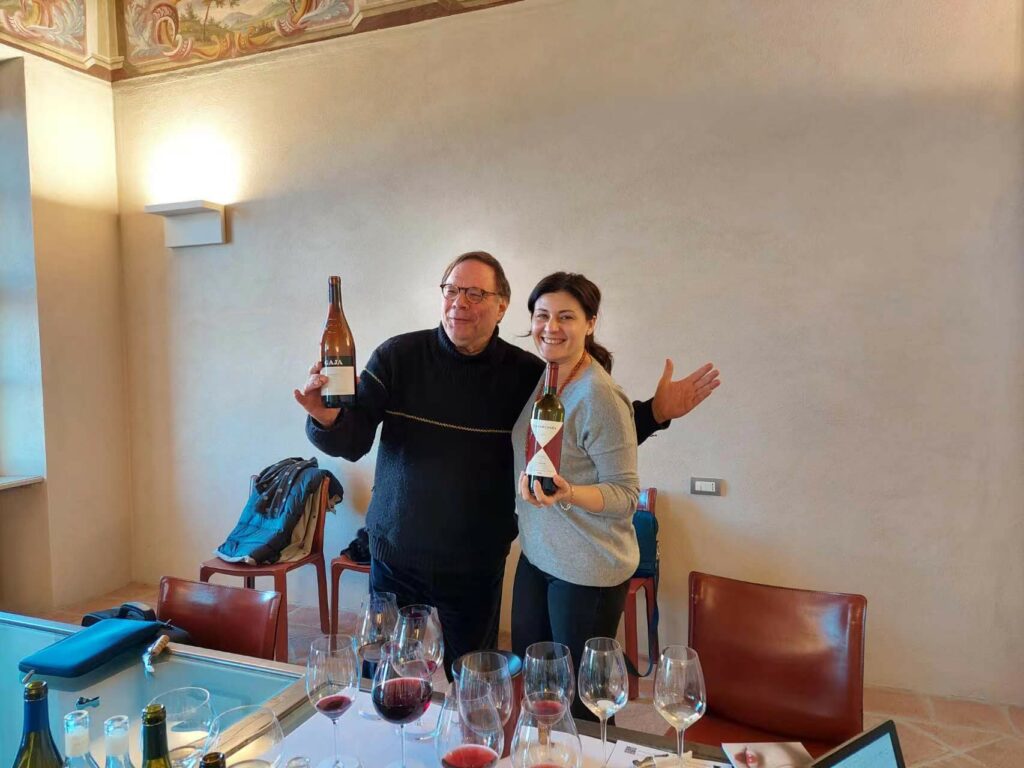
Gaja Barbaresco 2020 93
Light red colour. Pretty and perfumed but discreet, hinting at floral red berries and minerals. Then similar flavours to the aromas, finishing long and mineral fresh with a pleasant not massive mouthfeel. According to Gaia Gaja, this is not unlike their 2004 Barbaresco, because of the medium body and harmony, but she feels it also has a little of 2014 and 2016 (years with bigger berries because of a summertime rain) with a purity of fruit similar to the 2016. Recent vintages of the Gaja Barbaresco have struck me as being less dense than in the past, and the difference in these years at least with the cru wines is more noticeable than it was before (in fact, I have always though the classic Barbaresco to be the estate’s best wine, but now I’m not so sure). Drinking window: 2026-2036.
Gaja Barbaresco Costa Russi 2020 95
Deep, bright red. Vibrant aromas of dark red cherry, red berries, cocoa powder and leather. Juicy, bright and rich, with serious density and a solid spine of acidity and smooth tannins giving thrust to the powerful dark red fruit flavours. Closes with broad, smooth tannins and superb building length and lift, with a very pure ferrous/hematic quality that lingers nicely. More impactful than usual at such a young age, it offers a really big jump ijn density and complexity from the 2020 classic Barbaresco (much more so than I am used to). First Costa Russi since the 2017 (in 2018 it was not made because of hail, while in 2019 the hail of 2018 had consequences for the vineyard the following year, with less than homogenous ripening of the grapes), but the good news is the Costa Russi will be made again in 2021. Drinking window: 2027-2038.
Gaja Barbaresco Sori Tildin 2020 97
Luminous deep red. Very perfumed, downright magically inhebriating aromas and flavours of sweet spices, minerals and red fruit. The long aftertaste features clean, perfumed, mineral and spicy reminders that are at once pretty and serious. Beautiful rendition of this cru. Drinking window: 2028-2038.
Barbaresco Sori San Lorenzo 2020 96+
Deep red. Dense, brooding aromas of red cherry, blackberry, tobacco, leather and underbrush, complicated by hints of violet and cocoa. Big and massive in the mouth, with a brooding, closed down quality to its dark red and sweetly spicy tobacco flavours. This baby needs plenty of time in a good cellar to develop fully. Drinking window: 2028-2040.
Giuseppe Nada.
Giuseppe Nada 2019 Barbaresco Casot 94
Bright red. Lovely aromas and flavours of pepper, thyme, herbs, rhubarb, and red cherry. Very perfumed high acid personality of red cherry, red berries and minerals. Long and clean on the fresh spicy and juicy finish. Offers a pristine take on the lighter-bodied Barbarescos of Treiso. Drinking window: 2026-2038.
La Licenziana (Silvio Giamello).
La Licenziana (Silvio Giamello) 2020 Barbaresco Vicenziana 90
Good full red. Aromas of red cherry, rose and herbs. Enters very herbal, then slightly dilute in the middle, with red cherry nectar and mineral flavours. These grapes come from one of the most northern parts of Barbaresco territory, right above Ovello. Very traditional winemaking that will appeal to classicists, but i would have liked a touch more concentration for a higher score. Drinking window: 2025-2033.
Montaribaldi.
Named after Munta di Bord, the road that used to connect Alba and Canelli, but the winery was originally called Giuseppe Taliano (but as Taliano is a very common last name locally, they opted to change the name of to that of the subzone they are located in). Founded in 1968, the winery now owns 30 hectares (all of which under vine save for 0.3 hectares) and makes eighteen different wines. And as if producing all that wine isn’t enough, Montaribaldi has also turned into an importer, bringing into Italy three different Champagnes from the excellent little house of Lebeau-Batiste.
Montaribaldi 2019 Barbaresco Palazzina 92
Vivid red. Fresh and clean on the nose and in the mouth with plenty of acid bite to the aromas and flavours of orange peel, cinnamon and red cherry. In a cool rather than powerful style, this is an example of the gentler side of Neive Barbarecos. The name of the wine derives from the Borgata Palazin in the heart of the Starderi cru, and though it might seem strange to use a name other than that of the official cru, the fact is that the family has been using the Palazzina name since forever and so they do not wish to change it. Aged in 40% new oak and 60% first and second fill barriques. Drinking window: 2026-2036.
Montaribaldi 2019 Barbaresco Sorì Montaribaldi 92
Medium pale red with a hint of orange at the rim. Clean fresh and pure, with slightly subdued aromas of sweet spices and red cherry. Round and smoothly tannic, this closes long and textured. A very pretty lighter-bodied Barbaresco. Aged 24 months, eighteen of which in barriques (80% new oak) and then blended and aged in 20 hL large barrels for the remaining time. Drinking window: 2026-2036.
Montaribaldi 2018 Barbaresco Ricü 93
Bright red. Very pretty, easygoing aromas and flavours of red fruit, minty herbs and sweet spices. C;loses with compelling sweetness and lenght. Delicious. Aged 36 months in barriques. The wine’s name stems from Mr.Rico or Enrico who sold the current owners their house. Drinking window: 2026-2036.
Negro Giuseppe.
Negro Giuseppe 2019 Barbaresco Gallina 92+
Bright red. Perfumed, spicy and floral with ripe red cherry and mineral notes. Enters rich and ripe, then more lifted and freshly fruity, with a stony and spicy middle, but finishes with a slightly drying tanninc mouthfeel. I’d try cellaring this for four or five years more to see if the tannins smoothen somewhat, because there’s lots of promsie here. Drinking window: 2027-2038.
Orlando Abrigo.
Orlando Abrigo 2018 Barbaresco Meruzzano 91
Remarkably deep red colour. Slightly monolithic currently, with a tougher set of aromas and flavours that only hint at red fruit, camphor and spices. Finsihes long and vibrant but this needs a little time in a good cellar to have it hopefully develop a little more flesh. Drinking window: 2026-2036.
Paitin.
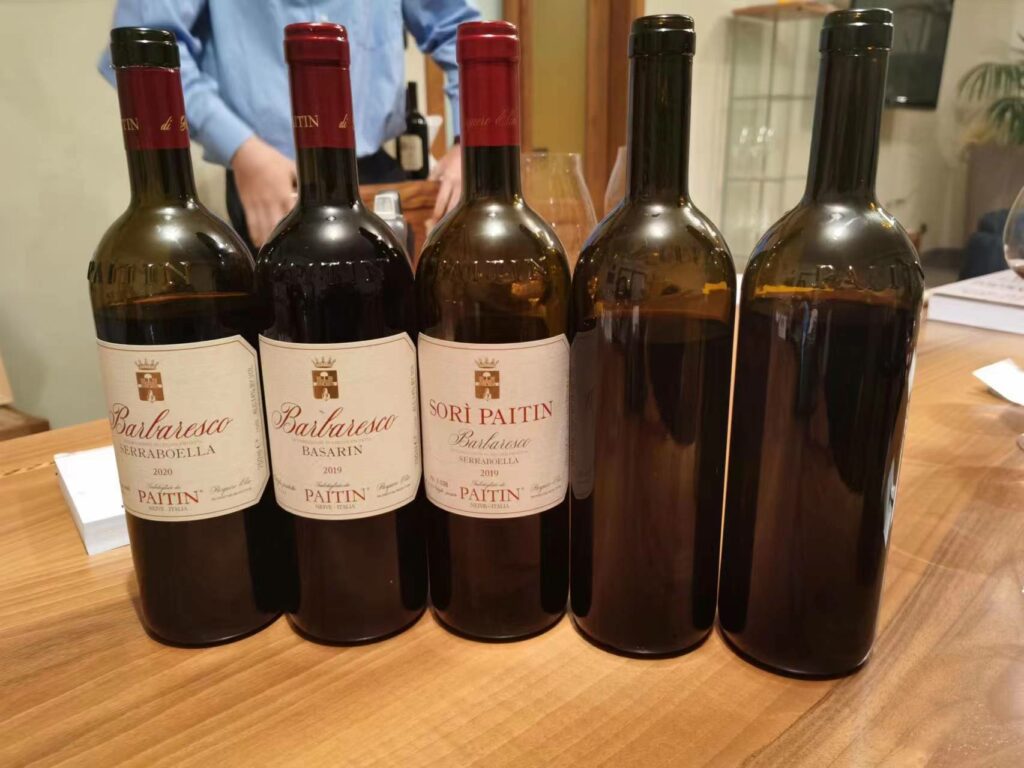
Paitin 2021 Freisa Bonina Langhe 91
Deep red; very beautiful colour. Pure red cherry and mineral aromas on the amazingly pure, concentrated and penetrating nose. Then slightly more diffuse on the palate, with mineral red fruit flavours that are long and clean but not especially concentrated. Well-delineated and precise. They avoid long macerations given Freisa’s tannins, choosing to extract delicately; for the first seven days they rack even if there’s some residual sugar and complete the fermentation as if it were a white wine. Bonina is the name of the villa’s vineyard where the Freisa grows, in the commune of Alba in the region of Rivoli (actually a very prestigious area for Nebbiolo), characterized by a lightly sandy but mostly clay and limestone soil. Drinking window: 2025-2030.
Paitin 2020 Barbaresco Basarin 92
Medium deep red. Perfumed aromas of red cherry, apricot and white pepper. Very fresh and light-bodied, with a delicately spicy, peppery nuance to the clean, sweet orchard fruit, strawberry and forest floor flavours. Closes long and lively. No blockbuster but fun to drink. Drinking window: 2026-2033.
Paitin 2020 Barbaresco Faset 93
Luminous red. Bright aromas of red cherry, strawberry, milk chocolate and minerals. Very open and broad in the mouth, with a penetrating citrussy acidity that really helps extend the ripe red cherry and smoky tobacco flavours on the long aftertaste. Drinking window: 2025-2035.
Paitin 2020 Barbaresco Serraboella 93
Moderately saturated red. Clean and fresh, with very lively pomegranate and red berry aromas and flavours complicated by minty herbs. This very pretty Barbaresco is less about power and more about perfume and refined texture. Drinking window: 2025-2035.
Paitin 2020 Barbaresco (Montestefano) 95
Good bright, dark red. Pure but restrained nose in typical Montestefano fashion shows good mineral lift to the aromas of red plum, red cherry, cocoa and spices. Densely built but weightless and sappy, offering fine-grained fruit and herbal flavours. At once nicely delineated and seamless, with plenty of power and lift on the long rising finish. First time they ever made this wine from grapes they exchanged with a friend for some of theirs in Serraboella. Only 1000 bottles made, but if you can try to find one. Drinking window: 2026-2036.
Piazzo.
A winery officially born in 1969 selling grapes and bulk wine, founded by Armando Piazzo and Gemma Veglio, they first bottled in 1979. The winery is large, with seventy hectares under vine (with vineyards in the Rizzi, Nervo, Rocche Massalupo and Pajorè crus) and Barolo (Sotto Castello di Novello). They produce a Barbaresco Pajorè since 2019, adding it to their three other Barbarescos: Argè (a blend of four vineyards, but Rocche Massalupo and Rizzi dominate); Rizzi (Vigna Fratin); and Nervo Riserva Vigna Giaia.
Piazzo 2020 Barbaresco Argè 92
Good bright red. Floral- and herbal-accented red fruit aromas. Very spicy entry, at once rich and round, with deep peppery, licorice and sweet red fruit on the long finish that features building tannins. Macerated twelve days at a maximum temperature of 26 degrees Celsiu, this stays 12 months on the lees in large 5000-7500 liter barrels. About 18-20,000 bottles a year. Drinking window: 2025-2035.
Piazzo 2020 Barbaresco Pajorè 94
Dark red, much more so than the Argè. Penetrating but ripe aromas of plum, red cherry, minerals and red roses. Rich, ripe, and round, with spicy sweet red cherry flavours that are long and clean, and leaving hints of cinnamon and nutmeg on the smooth finish. I really like how this wine combines sweetness with real power. Made from forty years old vines, and its shows in the wine’s subtle complexity and length. About 2,110 bottles made a year, all from the Rombone side of Pajorè. Aged 80% in 5000 liter barrels and 20% barriques (but the 2019 was all barrique-aged). Drinking window: 2025-2035.
Piazzo 2020 Barbaresco Rizzi Vigna Fratin 93+
Medium red. Extremely vertical nose typical of the Rizzi site (and in fact very similar to that of the Rizzi Barbaresco from the Rizzi estate), with light red berries, flowers and minerals dominating. Then at once hard and soft in the mouth with a whiplash of acidity and tough tannins framing ripe red cherry and pomegranate notes. Differently from the 2020 Pajorè, this is quite tannic but balanced, and the tannin is not due to the oak but a specific characteristic of the Rizzi cru. Austere wine, but really oustanding. Best after 2026. About 1700 bottles made. Drinking window: 2027-2037.
Piazzo 2016 Barbaresco Nervo Vigna Giaia 91
Good full red colour. Spicy, exotic aromas of yellow fruit, herbs, soy sauce, cumin, Sarawak pepper, and red tea. Still youthfully chewy but very pleasant. Very deep and concentrated in the mouth with red and black fruits, tobacco, marzipan, and orange peel. Lots of ripe fruit and coffee notes on the long back end. About 3060 bottles made. Drinking window: 2026-2036.
Piercarlo Culasso.
Piercarlo Culasso 2018 Barbaresco Faset Duesoli 90
Bright red. Smells ripe and fruity, then develops more in the way of underbrush and tea. Also herbal in the mouth, but with plenty of dark and red fruit flavours, with a rising hint of mushroom and a nutty final note. Drinking window: 2025-2035.
Pierpaolo Grasso.
Pierpaolo Grasso 2019 Barbaresco Tre Stelle 91
Vivid red. Aromas of violet and candied red cherry. Clean fresh and saline on the long mineral and steely back end. This made me think of whole bunches and of carbonic maceration, given its juicy floral and specific fruity nuances on the persistent finish. Not the most concentrated Barbaresco you will ever drink but fun. Drinking window: 2025-2035
Roberto Abellonio.
Roberto Abellonio 2019 Barbaresco Casot 90
Good full red. Camphor, strawberry, blueberry and licorice on the nose. Then big and ripe in the mouth, with camphor and ripe berry flavours that are broad and not very nuanced. Maybe a little too much alcohol and oak on the slightly chunky finish. Drinking window: 2025-2032.
Sassi San Cristoforo.
Sassi San Cristoforo 2019 Barbaresco 88
Bright red. Very simple, Burgundy Villages style wine that offers easygoing floral pomegranate and sour red cherry aromas and flavours. The finish is long but raisingly tannic and not especially complex. From the cru of San Cristoforo of Neive. Drinking window: 2026-2033.
Roagna.
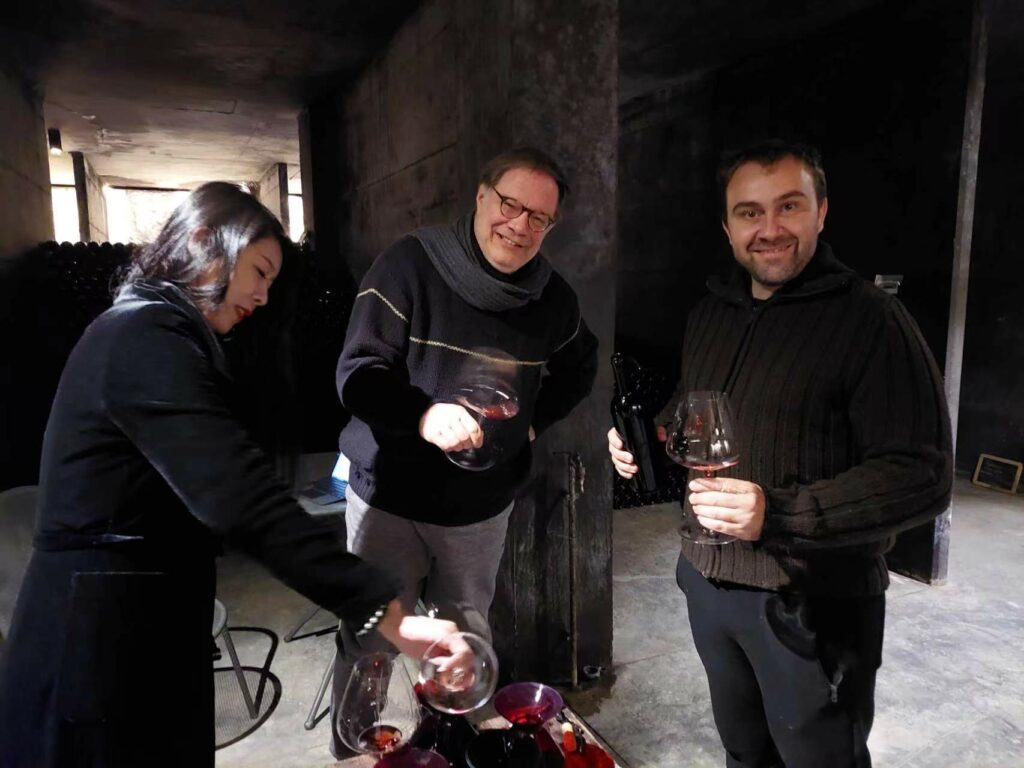
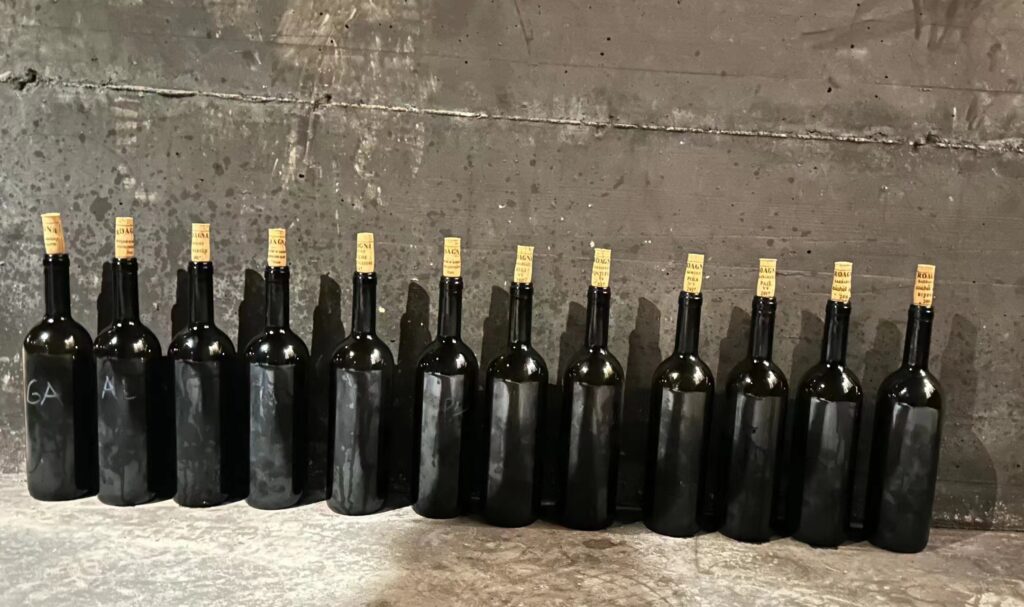
Roagna 2017 Barbaresco Gallina 93
Pale red. Very fresh strawberry and orange peel notes on the pungent nose. Then very juicy and less saline than some other Roagna Barbarescos, with a delicate herbal nuance to the red berry fruit flavours that linger nicely. About 5-8% whole stems were used. Five years in aging (about three years in 20 hl barrels and two years in cement, none in bottle). Drinking window: 2026-2033.
Roagna 2017 Barbaresco Albesani 94
Luminous red. Perfumed and deep aromas of ripe red cherry and plum, with a hint of tobacco in the background. Big powerful and dense, with rich bittersweet peppery strawberry flavours that are nicely framed by smooth tannins on the long close. About 5-8% whole stems were used but Albesani’s whte soil full of limestone makes the tannins stand out more than in the Gallina. Drinking window: 2026-2033.
Roagna 2017 Barbaresco Pajè 95
Moderately pale red with garnet highlights. Outstanding, truly very beautiful Barbaresco that is long and vibrant, boasting mineral red cherry and raspberry aromas and flavours. Extremely refined and poised for a long evolution in bottle, despite coming from such a hot vintage. Drinking window: 2028-2035.
Roagna 2017 Barbaresco Mntefico 94
Good bright medium red. Sexy, highly perfumed and deep aromas of red cherry, apricot and licorice. Dense, sweet and fine-grained, with rich flavours of strawberry, leather and licorice. Solidly structured as all of Roagna’s wines are, but finishing with even more power and firm tannins than usual, with excellent lift and length. Drinking window: 2026-2036.
Roagna 2017 Barbaresco Asili Vecchie Viti 95
Medium red. Wild aromas of raspberry, earth, dried flowers and minerals. Concentrated and seamless, showing a fine-grained texture to the precise flavours of sour red cherry, redcurrant and underbrush. Plenty of energy and definition, but not as complex or deep as the other Vecchie Viti bottlings which is in my experience almost always the case with these three famous Vecchie Viti bottlings. Showcases enticing lingering sweetness on the long close. Drinking window: 2026-2036.
Roagna 2017 Barbaresco Montefico Vecchie Viti 96
Medium very bright red. Slightly musky aromas of redcurrant, red plum, strawberry and sweet tobacco, complicated by a dusting of crushed rocks. Tactile, concentrated and silky, with enticing botanical reserve to the vivid flavours of red plum and minerals. Conveys an impression of strong extract and the harmonious acidity extends the flavours on the long clean rising finish. For my money, this is the best Vecchie Viti bottling in what was undoubtedly a very difficult vintage. Drinking window: 2026-2036.
Roagna 2017 Barbaresco Pajè Vecchie Viti 95
Vibrant garnet red. Deep brooding nose hints at dark cherry, red berries, peach and mushrooms. Then more open in the mouth, with mineral ad herbal accents to the slightly subdued red cherry fruit flavours. Less sweet and round than the Montefico and Asili Vecchie Viti bottlings, confirming the ballerina-like personality of this cru. Drinking window: 2026-2036.
Roagna 2014 Barbaresco Crichet Pajè 95
Good bright, full red with a garnet rim. Captivating aromas and flavours of raspberry, dried flowers, brown spices and mint. Suave and seamless but at the same time extremely vibrant and light on its feet, with salinity and refreshing acidity lifting the middle palate. Silky and sharply delineated, it finishes with excellent subtle persistence and energy. Though it will not be remembered as one of the great Crichet Pajè wines (and it would be really strange if it were), this is very stylish, and it showcases both Luca Roagna’s talent and how much better 2014 was in Barbaresco than in Barolo. Made with grapes picked in the high part of Pajè, only about 1600 bottles were made. Drinking window: 2026-2036.
Taverna.
Taverna 2020 Freisa Langhe Fer e Risu 90
Very deep ruby-red with purple tinges. Aromas and flavours of red and black cherry, minerals and violet. Silky and juicy on the long vibrant aftertaste. Drinking window: 2024-2028.
Taverna 2019 Freisa Langhe Fer e Risu 92
Bright deep red with a garnet tinge; to me, this is a much prettier colour than that of the 2020 excessively dark Freisa. Geranium and lavender on the nose lift rich red cherry notes. Then very fresh and vibrant with rising but noble tannins leaving a delicately mouthcoating freshness on the finish. Only 800 bottles were made as an experiment, but Taverna’s goal is to improve Freisa’s visibility and to do something positive for the variety, which he believes in. Made with 15% Barbera (the law allows it) and not yet made every year, the colour here does not reflect the presence of the barbera (while it certainly does so in the deep purple colour of the 2020). The 2019 is the first vintage made; the wine is called fer e risu, or iron and rust, a reference to the iron fist of the Freisa tannins but also the rusty colour it takes on especially with age (not surprising given that it is Nebbiolo’s closest relative). Drinking window: 2024-2028.
Taverna 2020 Barbaresco Cottà Senteùndes 94
Medium pale red (this is of an even lighter red hue than the 2019, but is less orangy-garnet). Deep earthy, red cherry and Oriental wood, with minerals, violet and quinine in the background. Sultry and sexy in the mouth, with spicy red fruit flavours and a long mineral edge on the youthfully chewy but noble finish. This resembles Cogno’s Vigna Elena to a good degree, as this is more massive and richer than the fruitier, open 2019. Picked end of September first ten days of October. Drinking window: 2026-20238.
Taverna 2019 Barbaresco Cottà Senteùndes 93+
Medium bright red with a strong garnet rim and tinge that are not at all a sign of precocious evolution but rather the hallmark of the Nebbiolo Rosé variety. Very pure red cherry nuances on the nose that are deep and mineral-etched. Then suave and rich with a good vibrancy and a sweet and herbal spicy finish (notably of chili pepper). I quite liked this but it needs food to show best and its tannic clout isn’t exactly shy. About 800-1000 bottles are made a year, aged in used tonneaux and barriques for about two years (at times two and a half years depending on the vintage characteristics). Drinking window: 2025-2036.
Taverna 2021 Barbaresco Gaia Principe 94
Luminous red. Lovely, pure aromas of flowers, cinnamaon, red cherry and raspberry. Then similar flavours, with lovely balance. The finish is nicely sweet and spicy and features repeating floral cut. Lovely. Very different from the bigger fleshier balsamic 2019, this tastes as if there is a little Nebbiolo Rosé in the mix, but apparently there is none. For sure, the tannin load is much more hefty than that of the Cottà. No 2020 was made because of all the problems related to Covid, they did not make a Gaia Principe bottling but made a blend of the two crus (Cottà and Gaia Principe ) instead. Drinking window: 2025-2036.
Taverna 2019 Barbaresco Gaia Principe 92
Good full red with an garnet rim. Red cherry, balsamic and sweet spices on the nose. The ripe and peppery in the mouth but with very good acidity lifting and extending the ripe red and blue fruit flavours on the long juicy back end. Much larger and fleshier than the Cottà pr the 2021 Gaia Principe. Only about 1500-2000 bottles a year, this is entirely sold to a Danish client. It was first made in 2016 but labeled only as a Barbaresco, becoming Gaia Principe with the 2019 vintage. Drinking window: 2025-2035.
Vigin.
Vigin 2018 Barbaresco Cottà Nonn’Orlando 92
Bright red. Perfumed and well-balanced aromas and flavours of red fruit, cinnamon and minerals. Actually pretty good, rich ripe and light on its feet finishing long with repeating red fruit nuances mostly and some herbs and tar. A steely mineral note typical of the commune’s wines emerges with aeration. Drinking window: 2025-2035.

 中文
中文



